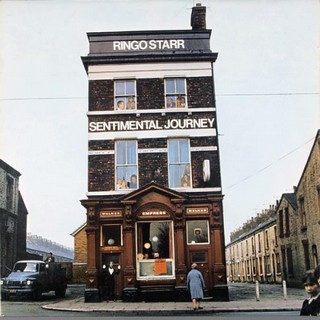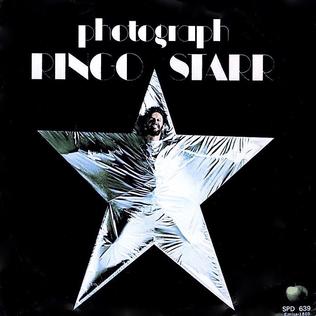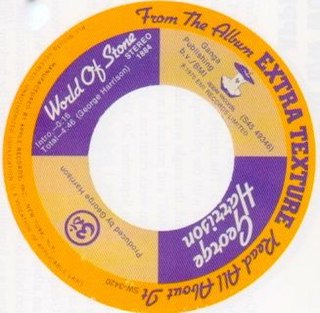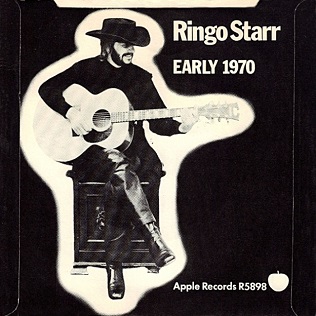Related Research Articles

Extra Texture (Read All About It) is the sixth studio album by the English musician George Harrison, released on 22 September 1975. It was Harrison's final album under his contract with Apple Records and EMI, and the last studio album issued by Apple. The release came nine months after his troubled 1974 North American tour with Ravi Shankar and the poorly received Dark Horse album.

Dark Horse is the fifth studio album by the English rock musician George Harrison. It was released on Apple Records in December 1974 as the follow-up to Living in the Material World. Although keenly anticipated on release, Dark Horse is associated with the controversial North American tour that Harrison staged with Indian classical musician Ravi Shankar in November and December that year. This was the first US tour by a member of the Beatles since 1966, and the public's nostalgia for the band, together with Harrison contracting laryngitis during rehearsals and choosing to feature Shankar so heavily in the programme, resulted in scathing concert reviews from some influential music critics.
The discography of English singer-songwriter and former Beatle George Harrison consists of 12 studio albums, two live albums, four compilation albums, 35 singles, two video albums and four box sets. Harrison's first solo releases – the Wonderwall Music film soundtrack (1968) and Electronic Sound (1969) – were almost entirely instrumental works, issued during the last two years of the Beatles' career. Following the band's break-up in April 1970, Harrison continued to produce recordings by his fellow Apple Records acts, notably former bandmate Ringo Starr. He recorded and collaborated with a wide range of artists, including Shankar, Bob Dylan, Eric Clapton and Gary Wright.

Sentimental Journey is the debut solo album by the English rock musician Ringo Starr. It was released by Apple Records in March 1970 as the Beatles were breaking up. The album is a collection of pre-rock 'n' roll standards that Starr recalled from his childhood in Liverpool. As a departure from the experimental quality that had characterised solo LPs by George Harrison and John Lennon since 1968, it was the first studio album by an individual Beatle to embrace a popular music form.

"It Don't Come Easy" is a song by the English rock musician Ringo Starr that was released as a non-album single in April 1971. It was produced by Starr's former Beatles bandmate George Harrison, who also helped write the song, although only Starr is credited. Recording for the track took place in March 1970 at Trident Studios in London, with overdubs added in October. Starr and Harrison performed the song together in August 1971 at Harrison's Concert for Bangladesh shows in New York City, a recording from which was released on the live album of the same name. Starr has continued to perform it in subsequent decades with his All-Starr Band.

"Photograph" is a song by English rock musician Ringo Starr that was released as the lead single from his 1973 album Ringo. Starr co-wrote it with George Harrison, his former bandmate from the Beatles. Although they collaborated on other songs, it is the only one officially credited to the pair. A signature tune for Starr as a solo artist, "Photograph" was an international hit, topping singles charts in the United States, Canada and Australia, and receiving gold disc certification for US sales of 1 million. Music critics have similarly received the song favourably; Stephen Thomas Erlewine of AllMusic considers it to be "among the very best post-Beatles songs by any of the Fab Four".
"I'm the Greatest" is a song written by English musician John Lennon that was released as the opening track of the 1973 album Ringo by Ringo Starr. With Starr, Lennon and George Harrison appearing on the track, it marks the only time that three former Beatles recorded together between the band's break-up in 1970 and Lennon's death in 1980. Lennon wrote the song in December 1970 as a wry comment on his rise to fame, and later tailored the lyrics for Starr to sing. Named after one of Muhammad Ali's catchphrases, the song partly evokes the stage-show concept of the Beatles' 1967 album Sgt. Pepper's Lonely Hearts Club Band.

"Back Off Boogaloo" is a song by the English rock musician Ringo Starr that was released as a non-album single in March 1972. Starr's former Beatles bandmate George Harrison produced the recording and helped Starr write the song, although he remained uncredited as a co-writer until 2017. Recording took place in London shortly after the pair had appeared together at Harrison's Concert for Bangladesh shows in August 1971. The single was a follow-up to Starr's 1971 hit song "It Don't Come Easy" and continued his successful run as a solo artist. "Back Off Boogaloo" peaked at number 2 in Britain and Canada, and number 9 on America's Billboard Hot 100. It remains Starr's highest-charting single in the United Kingdom.
"Don't Let Me Wait Too Long" is a song by English rock musician George Harrison, released on his 1973 album Living in the Material World. It was scheduled to be issued as a single in September that year, as the follow-up to "Give Me Love ", but the release was cancelled. Music critics have traditionally viewed "Don't Let Me Wait Too Long" as a highlight of the Material World album, praising its pop qualities and production, with some considering the song worthy of hit status.
"Sue Me, Sue You Blues" is a song written by English musician George Harrison, released on his 1973 album Living in the Material World. Harrison initially let American guitarist Jesse Ed Davis record it for the latter's Ululu album (1972), in gratitude to Davis for his participation in the Concert for Bangladesh. When writing the song, Harrison drew inspiration from the legal issues surrounding the Beatles during the early months of 1971, particularly the lawsuit that Paul McCartney initiated in an effort to dissolve the band's business partnership, Apple Corps.
"The Day the World Gets 'Round" is a song by English musician George Harrison, released on his 1973 album Living in the Material World. Harrison was inspired to write the song following the successful Concert for Bangladesh shows, which were held in New York on 1 August 1971 as a benefit for refugees from the country formerly known as East Pakistan. The lyrics reflect his disappointment that such a humanitarian aid project was necessary, given the abundance of resources available across the planet, and his belief that if all individuals were more spiritually aware, there would be no suffering in the world. Adding to Harrison's frustration while writing the song, the aid project became embroiled in financial problems, as commercial concerns delayed the release of the Concert for Bangladesh album, and government tax departments failed to embrace the goodwill inherent in the venture.

"World of Stone" is a song by English rock musician George Harrison, released in 1975 on Extra Texture , his final album for Apple Records. It was also issued as the B-side of the album's lead single, "You". Harrison wrote the song in 1973 but recorded it two years later, following the unfavourable critical reception afforded his 1974 North American tour with Ravi Shankar and the Dark Horse album. Due to its context on release, commentators view "World of Stone" as a plea from Harrison for tolerance from these detractors. According to some of his biographers, the lyrics reflect Harrison's doubts regarding his devotion to a spiritual path – an apparent crisis of faith that followed his often-unwelcome spiritual pronouncements during the tour, and which permeated his work throughout 1975.

"Early 1970" is a song by the English rock musician Ringo Starr that was released as the B-side of his April 1971 single "It Don't Come Easy". A rare example of Starr's songwriting at the time, it was inspired by the break-up of the Beatles and documents his relationship with his three former bandmates. The lyrics to the verses comment in turn on Paul McCartney, John Lennon and George Harrison as individuals, and the likelihood of each of them making music with Starr again. In the final verse, Starr offers a self-deprecating picture of his musical abilities and expresses the hope that all four will play together in the future. Commentators have variously described "Early 1970" as "a rough draft of a peace treaty" and "a disarming open letter" from Starr to Lennon, McCartney and Harrison.
"Sunshine Life for Me (Sail Away Raymond)" is a song by the English musician Ringo Starr from his 1973 album Ringo. It was written by George Harrison, Starr's former bandmate in the Beatles, and was one of several contributions Harrison made to Ringo. Recording for the song took place in Los Angeles in March 1973, with Richard Perry as producer. In addition to Starr and Harrison, the musicians on the track include Levon Helm, Robbie Robertson, Rick Danko and Garth Hudson of the Band, and multi-instrumentalist David Bromberg.
"Can't Stop Thinking About You" is a song by English musician George Harrison, released in 1975 on his final album for Apple Records, Extra Texture . A love song in the style of a soul/R&B ballad, it was written by Harrison in December 1973, towards the end of his marriage to Pattie Boyd and while he was having an affair with Maureen Starkey, the wife of his former Beatles bandmate Ringo Starr. Having first considered the song for his 1974 release Dark Horse, Harrison recorded "Can't Stop Thinking About You" in Los Angeles in May 1975 for his so-called "soul album", Extra Texture. Some authors view its inclusion on the latter release as an obvious attempt by Harrison to commercialise the album, in response to the harsh critical reception afforded Dark Horse and his 1974 North American tour.
"His Name Is Legs (Ladies and Gentlemen)" is a song by English rock musician George Harrison, released in 1975 as the closing track of his album Extra Texture (Read All About It). The song is a tribute to "Legs" Larry Smith, the drummer with the 1960s satirical-comedy group the Bonzo Dog Doo-Dah Band and one of many comedians with whom Harrison began associating during the 1970s. Smith appears on the recording, delivering a spoken monologue, while Harrison's lyrics similarly reflect the comedian's penchant for zany wordplay. The song serves as a precursor to Harrison's work with Monty Python members Eric Idle and Michael Palin, including his production of the troupe's 1975 single "The Lumberjack Song" and films such as Life of Brian (1979) that he produced under the aegis of his company HandMade Films.
"Six O'Clock" is a song by the English rock musician Ringo Starr from his 1973 album Ringo. It was written by Starr's former Beatles bandmate Paul McCartney and the latter's wife, Linda, who also participated in the recording of the song. It was the first time McCartney and Starr had worked together since the Beatles' break-up in 1970. Their collaboration reflected an easing of the tensions that had existed between the two musicians for much of that period.
"I'll Still Love You" is a song written by English rock musician George Harrison and first released in 1976 by his former Beatles bandmate Ringo Starr. Produced by Arif Mardin, the track appeared on Starr's debut album for Atlantic Records and Polydor, Ringo's Rotogravure. The composition had a long recording history before then, having been written in 1970 as "Whenever", after which it was copyrighted with the title "When Every Song Is Sung".
"So Sad" is a song by English rock musician George Harrison that was released on his 1974 album Dark Horse. Harrison originally recorded the song for his previous album, Living in the Material World, before giving it to Alvin Lee, the guitarist and singer with Ten Years After. Lee recorded it – as "So Sad " – with gospel singer Mylon LeFevre for their 1973 album On the Road to Freedom. The latter recording includes contributions from Harrison and marked the first of several collaborations between him and Lee.

"I Am Missing You" is a song by Indian musician Ravi Shankar, sung by his sister-in-law Lakshmi Shankar and released as the lead single from his 1974 album Shankar Family & Friends. The song is a rare Shankar composition in the Western pop genre, with English lyrics, and was written as a love song to the Hindu god Krishna. The recording was produced and arranged by George Harrison, in a style similar to Phil Spector's signature sound, and it was the first single issued on Harrison's Dark Horse record label. Other contributing musicians include Tom Scott, Nicky Hopkins, Billy Preston, Ringo Starr and Jim Keltner. A second version appears on Shankar Family & Friends, titled "I Am Missing You (Reprise)", featuring an arrangement closer to a folk ballad.
References
- ↑ Rodriguez, pp. 83, 85.
- ↑ Leng, pp. 138–39.
- ↑ O'Dell, pp. 246–47.
- ↑ Clayson, pp. 105–06.
- ↑ Spizer, pp. 50, 338, 341.
- ↑ Doggett, pp. 30–31, 36, 82.
- ↑ Spizer, p. 338.
- ↑ Castleman & Podrazik, pp. 77, 102.
- ↑ Doggett, pp. 240–41.
- ↑ Castleman & Podrazik, p. 150.
- ↑ Leng, p. 142.
- ↑ Badman, pp. 90, 129.
- ↑ Michael Simmons, "Cry for a Shadow", Mojo , November 2011, pp. 84–85.
- ↑ Madinger & Easter, pp. 500–01.
- 1 2 3 4 Rodriguez, p. 35.
- 1 2 3 4 5 6 Spizer, p. 308.
- ↑ Rodriguez, p. 158.
- ↑ Castleman & Podrazik, p. 370.
- ↑ Rodriguez, p. 241.
- ↑ MacDonald, p. 206fn.
- ↑ Schaffner, p. 161.
- 1 2 3 4 Inglis, p. 56.
- 1 2 MacFarlane, p. 89.
- ↑ Badman, pp. 91, 92.
- ↑ Doggett, p. 199.
- ↑ Spizer, p. 306.
- ↑ MacFarlane, pp. 88–89.
- ↑ Badman, p. 91.
- ↑ Leng, pp. 139–40.
- ↑ Clayson, p. 242.
- ↑ Castleman & Podrazik, p. 212.
- ↑ Woffinden, p. 77.
- ↑ Spizer, pp. 306, 308.
- ↑ Castleman & Podrazik, p. 213.
- ↑ Madinger & Easter, p. 507.
- ↑ Badman, p. 111.
- ↑ Castleman & Podrazik, p. 128.
- ↑ MacFarlane, pp. 88, 89.
- ↑ MacFarlane, pp. 89, 109.
- ↑ Madinger & Easter, p. 506.
- ↑ Rodriguez, pp. 143, 157.
- ↑ Frontani, p. 156.
- ↑ Schaffner, pp. 160–61.
- ↑ Carr & Tyler, p. 109.
- ↑ Clayson, p. 243.
- ↑ Woffinden, p. 75.
- ↑ MacFarlane, pp. 92, 108.
- ↑ Huntley, p. 111.
- ↑ MacFarlane, p. 108.
- ↑ Madinger & Easter, p. 444.
- ↑ Clayson, p. 271.
- ↑ Bob Woffinden, "Ringo Starr: Everyone One of Us Has All We Need …", NME , 12 April 1975; available at Rock's Backpages (subscription required).
- ↑ Castleman & Podrazik, p. 313.
- ↑ Clayson, pp. 271–72.
- ↑ Woffinden, p. 78.
- ↑ Ben Gerson, ""Ringo Starr Ringo"". Rolling Stone . Archived from the original on 1 October 2007. Retrieved 1 July 2013., Rolling Stone , 20 December 1973, p. 73 (retrieved 22 January 2014).
- ↑ Woffinden, pp. 75, 84.
- ↑ Alan Betrock, "Ringo Starr: Ringo", Phonograph Record , December 1973; available at Rock's Backpages (subscription required).
- ↑ Huntley, p. 97.
- ↑ Leng, pp. 139, 140.
- ↑ Leng, p. 140.